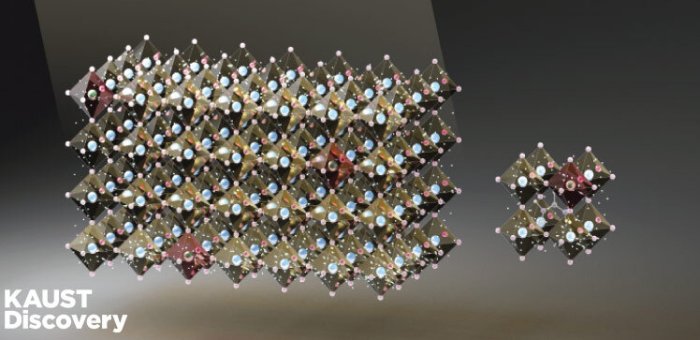Eddie Gonzales Jr. – MessageToEagle.com – Tiny crystals, known as quantum dots, have enabled an international team to achieve a quantum efficiency exceeding 100 percent in the photocurrent generated in a hybrid inorganic-organic semiconductor.

By synthesizing a semiconducting material containing tin-based nanoparticles known as quantum dots, an international team of researchers including KAUST achieved impressive light-power conversion. Credit: KAUST/Heno Hwang
Perovskites are exciting semiconductors for light-harvesting applications and have already shown some impressive performances in solar cells. But improvements in photo-conversion efficiency are necessary to take this technology to a broader market.
Light comes in packets of energy known as photons. When a semiconductor absorbs a photon, the electromagnetic energy is transferred to a negatively charged electron and its positively charged counterpart, known as a hole. An electric field can sweep these particles in opposite directions, thereby allowing a current to flow. This is the basic operation of a solar cell. It might sound simple, but optimizing the quantum efficiency, or getting as many electron-hole pairs from the incoming photons as possible, has been a long-standing goal.
One cause of inefficiency is that if the photon has more energy than is needed to create the electron-hole pair, the excess energy is usually lost as heat. But nanomaterials offer a solution. Small particles, such as nanocrystals or quantum dots, can convert high-energy photons into more than one electron-hole pair.
Jun Yin and Omar Mohammed from KAUST worked with Yifan Chen and Mingjie Li from Hong Kong Polytechnic University and their colleagues to demonstrate this so-called multiple exciton generation (MEG) in nanocrystals of tin-lead halide perovskite. “We demonstrated a photocurrent quantum efficiency exceeding 100 percent by harnessing MEG in the perovskite nanocrystal devices,” says Yin.
In the past, MEG has been observed in perovskite nanocrystals with a large bandgap: that is, those semiconductors that can only absorb high-energy photons.
Narrower-bandgap materials present a greater challenge because the excited electron-hole pairs relax, or cool, too fast for them to be extracted in a functioning solar cell device. “Efficient MEG in narrower-bandgap perovskite nanocrystals and verification of their inherent MEG in practical optical devices have not been reported,” says Yin.
Chen, Yin and the team synthesized a semiconducting material composed of tiny particles of formamidinium tin–lead iodide perovskite—made using small amounts of tin—embedded in tin-free FAPbI3. The team believe that the introduction of tin helps to slow the “cooling.” “We will be able to further optimize the perovskite nanocrystal by altering its composition to obtain higher MEG performance and improved the light-power conversion,” says Yin.
The research was published in Nature Photonics.
Written by Eddie Gonzales Jr. – MessageToEagle.com Staff






